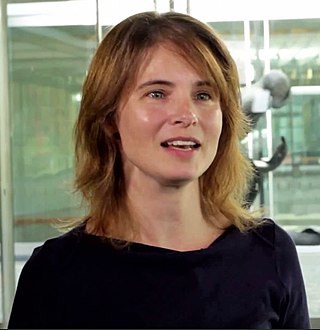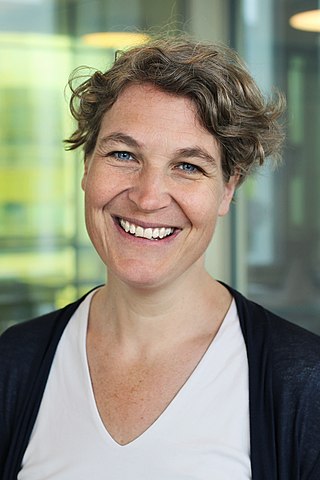Related Research Articles

The zebrafish is a freshwater fish belonging to the minnow family (Cyprinidae) of the order Cypriniformes. Native to South Asia, it is a popular aquarium fish, frequently sold under the trade name zebra danio. It is also found in private ponds.

Christiane (Janni) Nüsslein-Volhard is a German developmental biologist and a 1995 Nobel Prize in Physiology or Medicine laureate. She is the only woman from Germany to have received a Nobel Prize in the sciences.

Ewine Fleur van Dishoeck is a Dutch astronomer and chemist. She is Professor of Molecular Astrophysics at Leiden Observatory, and served as the President of the International Astronomical Union (2018–2021) and a co-editor of the Annual Review of Astronomy and Astrophysics (2012–present). She is one of the pioneers of astrochemistry, and her research is aimed at determination of the structure of cosmic objects using their molecular spectra.
Christine Borland is a Scottish artist. Born in Darvel, Ayrshire, Scotland, Borland is one of the Young British Artists (YBAs) and was nominated for the Turner Prize in 1997 for her work From Life at Tramway, Glasgow. Borland works and lives in Kilcreggan, Argyll, as a BALTIC Professor at the BxNU Institute of Contemporary Art.

The Zebrafish Information Network is an online biological database of information about the zebrafish. The zebrafish is a widely used model organism for genetic, genomic, and developmental studies, and ZFIN provides an integrated interface for querying and displaying the large volume of data generated by this research. To facilitate use of the zebrafish as a model of human biology, ZFIN links these data to corresponding information about other model organisms and to human disease databases. Abundant links to external sequence databases and to genome browsers are included. Gene product, gene expression, and phenotype data are annotated with terms from biomedical ontologies. ZFIN is based at the University of Oregon in the United States, with funding provided by the National Institutes of Health (NIH).

Nancy Hopkins, an American molecular biologist, is the Amgen, Inc. Professor of Biology at the Massachusetts Institute of Technology. She is a member of the National Academy of Sciences, the Institute of Medicine of the National Academy, and the American Academy of Arts and Sciences. She is known for her research identifying genes required for zebrafish development, and for her earlier research on gene expression in the bacterial virus, lambda, and on mouse RNA tumor viruses. She is also known for her work promoting equality of opportunity for women scientists in academia.
The Genetics Society of America (GSA) is a scholarly membership society of more than 5,500 genetics researchers and educators, established in 1931. The Society was formed from the reorganization of the Joint Genetics Sections of the American Society of Zoologists and the Botanical Society of America.

Christine Anne Orengo is a Professor of Bioinformatics at University College London (UCL) known for her work on protein structure, particularly the CATH database. Orengo serves as president of the International Society for Computational Biology (ISCB), the first woman to do so in the history of the society.
Lisa Steiner is a professor of immunology in the department of biology at the Massachusetts Institute of Technology. When she arrived at MIT in 1967, she was the first woman faculty member in the department. Her research focuses on the evolution and development of the immune system, using zebrafish as a model organism.

Catherina Gwynne Becker is an Alexander von Humboldt Professor at TU Dresden, and was formerly Professor of Neural Development and Regeneration at the University of Edinburgh.

Didier Stainier is a Belgian/American developmental geneticist who is currently a director at the Max Planck Institute for Heart and Lung Research in Bad Nauheim, Germany.

John H. Postlethwait is a professor of biology and author at University of Oregon.
Renee Elizabeth Sockett is a professor and microbiologist in the School of Life Sciences at the University of Nottingham. She is a world-leading expert on Bdellovibrio bacteriovorus, a species of predatory bacteria.

Melina Elisabeth Hale is an American neuroscientist and biomechanist. She is William Rainey Harper Professor in the Department of Organismal Biology and Anatomy, at the University of Chicago.
Joanna Yvonne Wilson is a Canadian aquatic toxicologist and physiologist. Wilson is a multidisciplinary scientist whose work intersects the fields of environmental physiology, biochemistry, toxicology, bioinformatics and functional genomics. Her research focuses on studying cytochrome P450 enzymes and the effects of environmental contaminants on marine and freshwater species, the most notable being the impact of pharmaceuticals in the environment. She is a professor in the department of biology at McMaster University in Hamilton, Ontario, Canada.
Cecilia Moens is a Canadian developmental biologist. Moens is part of the faculty at the Fred Hutchinson Cancer Research Center in Seattle, Washington, where she researches the vertebrate brain using zebrafish as a model organism.
Julia Anne Horsfield is a New Zealand biochemist and developmental geneticist. She is professor of pathology at the University of Otago and director of Genetics Otago and the Otago Zebrafish Facility.
Elizabeth Patton, Ph.D FRSE is professor of chemical genetics and group leader of Medical Research Council Institute for Genetics and Molecular Medicine (IGMM) Human Genetics Unit in Edinburgh, Personal Chair of Melanoma Genetics and Drug Discovery for a disease which kills 20,000 Europeans a year, and accounts for 80% of all skin cancer deaths. Her research into the genetic models and drug interactions testing, sharing international findings, is mainly using zebrafish in conjunction with the Edinburgh Cancer Research Centre. She holds a number of academic leadership roles in UK, Europe and international scientific bodies.

Andrea Pauli is a developmental biologist and biochemist studying how the egg transitions into an embryo, and more specifically the molecular mechanisms underlying vertebrate fertilisations, egg dormancy, and subsequent egg activation. Her lab uses zebrafish as the main model organism. Andrea Pauli is a group leader at the Research Institute of Molecular Pathology (IMP) at the Vienna Biocenter in Austria.

The Biomedical Research Center (BRC) is a research center at Qatar University focusing on biomedical research. BRC was founded in 2014, and partners with the Ministry of Public Health (Qatar), and Hamad Medical Corporation (HMC).
References
- 1 2 3 4 5 "Christine Beattie (1965 - 2018) - Obituary". www.legacy.com. Retrieved 2020-10-27.
- ↑ "Christine Beattie Award | IZFS - International Zebrafish Society". www.izfs.org. Retrieved 2020-10-27.